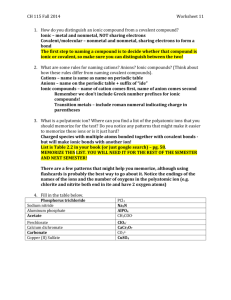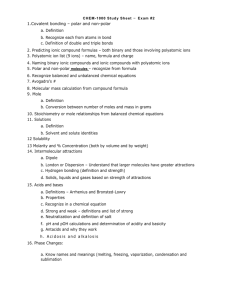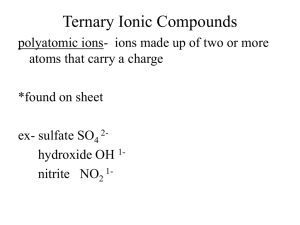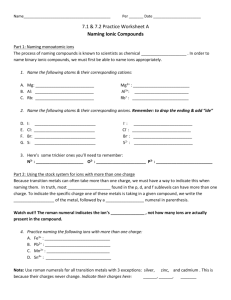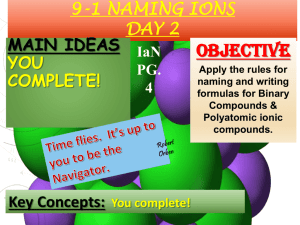AP Chemistry
advertisement
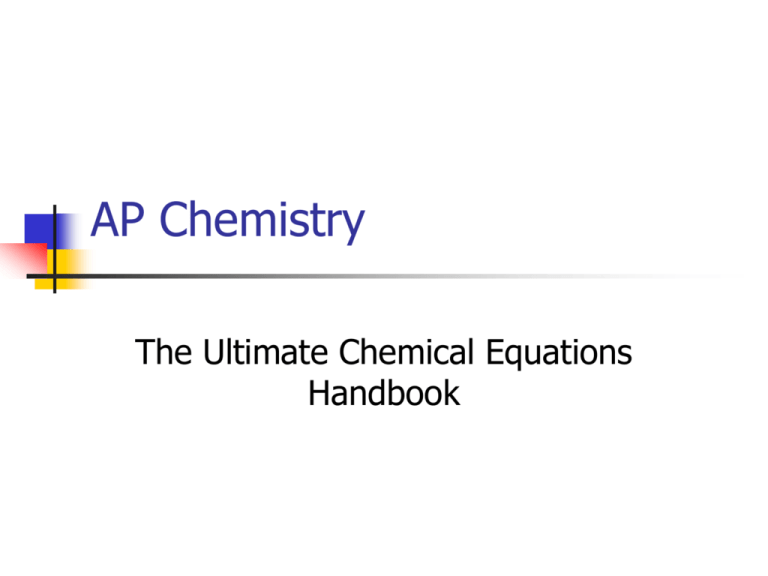
AP Chemistry The Ultimate Chemical Equations Handbook HOMEWORK Do all exercises in this book on a separate sheet of paper. DO NOT WRITE IN THE BOOK. Chapter 1 Symbols and Nomenclature of the elements There is interesting info where the elements got their name, but nothing we will cover. Chapter 2 and 3 Naming Binary Compounds First, determine if you have an ionic compound or a covalent compound. A metal and a nonmetal will form an ionic bond. Compounds with Polyatomic ions form ionic bonds. Nonmetals bonding together or Nonmetals and a metalloid form covalent bonds. Covalent bonding is very similar to ionic naming You always name the one that is least electronegative first (furthest from fluorine) Most electronegative last, and gets the suffix “-ide”. Covalent bonding is very different from ionic naming Ionic names ignored the subscript because there was only one possible ratio of elements. Covalent gives several possibilities so we have to indicate how many of each atom is present in the name Prefixes you have to know prefix meaning prefix meaning *mono- 1 hex- 6 di- 2 hept- 7 tri- 3 oct- 8 tetr- 4 non- 9 pent- 5 dec- 10 * the first atom named does not get the prefix “mono-”, it just keeps its original name! Examples CO carbon monoxide CO2 carbon dioxide NI3 nitrogen triiodide P4O6 tetraphosphorus hexoxide Continuing I4O9 tetriodine nonoxide S2F10 disulfur decafluoride IF7 Iodine heptafluoride Si2Cl6 disilicon hexachloride Naming ionic compounds For monoatomic anions only drop the ending and add “-ide” so Ffluoride Cl-, O2-, C4chloride, oxide and carbide Continuing… cations keep the name of the element. When naming compounds always name the positive (cation) first and the negative (anion) last. so mixing ions of chlorine and sodium give you sodium chloride (positive) (negative) Determining the formula of ions Ionic compounds are neutral You need to find the lowest number of each ion to make it neutral for example: Na+ and O22 sodium for every one oxygen Na2O More examples Al3+ and O2Al2O3 K+ and ClKCl the subscripts don’t effect the name if there is only one possibility still (cation)(anion) Aluminum oxide Potassium chloride Several atoms can form a couple of different ions. All of these are metals that are not in group 1, 2 or aluminum. for example iron can form Fe2+ or Fe3+ These are said as iron (II) and iron (III) Cu+ and Cu2+ is Copper (I) and Copper (II) Figuring out charge on these elements If the ion is named, the charge is in the name. If you have the formula, use the charges of the other ions present to determine the charge. Remember Alkali will always be +1 Alkaline Earth +2, Halogens -1, oxygen group -2 Aluminum will always be +3 Examples Copper (II) chloride CuCl2 Cobalt (III) sulfide Co2S3 NiF2 Nickel (II) fluoride TiS2 titanium (IV) sulfide Polyatomic ions Polyatomic Ions- many atoms in one ion You can NOT break these apart in this section. the “ide” suffix only applies to monoatomic anions Common polyatomic ions Sulfate Ammonium NH4+ Perchlorate ClO4- Acetate CH3CO2- Chlorate ClO3- Nitrate NO3- Chlorite Nitrite NO2- Hypochlorite ClO- Dichromate Cr2O72- Cyanide CN- Iodate IO3- Chromate CrO42- Thiocyanate SCN- Bromate BrO3- Oxalate C2O42- Hydrogen carbonate Hydrogen sulfate Hydrogen sulfite ClO2- Sulfite Carbonate SO42SO32CO32- Hydroxide OH- Silicate SiO32- HSO4- Permanganate MnO4- Phosphate PO43- HSO3- Thiosulfate S2O32- Arsenate AsO43- HCO3- YOU WILL HAVE TO MEMORIZE THESE! This is one of the big differences from last year. We will have a quiz just like the elements quiz last year over these! Determining the formula of ions Ionic compounds are neutral Remember– don’t break a polyatomic ion apart for example: Ammonium carbonate NH4+ and CO32(NH4)2CO3 Chapter 4 acids and salts Oxyanions- negative ions containing oxygen. These have the suffix “-ate” or “-ite” “-ate” means it has more oxygen atoms bonded, “-ite” has less For example SO42- sulfate SO32- sulfite Oxyanions Oxyanions may contain the prefix “hypo-”, less than, or “per-”, more than. For example ClO4Perchlorate ClO3Chlorate ClO2Chlorite ClOHypochlorite Acids Certain compounds produce H+ ions in water, these are called acids. You can recognize them because the neutral compound starts with “H”. For example HCl, H2SO4, and HNO3. Don’t confuse a polyatomic ion with a neutral compound. HCO3- is hydrogen carbonate (or bicarbonate), not an acid. Naming acids Does it contain oxygen? If it does not, it gets the prefix “hydro-” and the suffix “-ic acid” HCl Hydrochloric acid HF Hydroflouric acid HCN Hydrocyanic acid Naming Acids If it does contain an oxyanion, then replace the ending. If the ending was “–ate”, add “-ic acid” If the ending was “–ite”, add “-ous acid” H2SO4 Sulfuric Acid H2SO3 Sulfurous Acid Examples HNO3 HI H3AsO3 Chapter 5 Complex ions Complex ion- transition metal ion with attached ligands Fe(CN)63Glance over this chapter. Skip the problems, this material is out of the test. Ch 6 Organic Alkanes- straight chain hydrocarbons with all single bonds Alkenes- hydrocarbons with a double bond Alkynes- hydrocarbons with a triple bond Cyclic hydrocarbons- rings Root words Meth # of C atoms 1 Hex # of C atoms 6 Eth 2 Hept 7 Prop 3 Oct 8 But 4 Non 9 Pent 5 Dec 10 Name this molecule And give its molecular formula 4 ethyl octane C10H22 4 propyl decane C13H28 Name and give the formula Methyl cyclohexane C7H14 Functional groups halogenated *R means any carbon chain Alcohols R-OH -al -oic acid Ketones NOT at the edge R-C-R =O Aldehydes at the edge R=O R-C=O -OH -ol Carboxylic Acids -one 2,4 dichloro 3 methyl 1 cyclobutanone C5H6Cl2O 2, 3 dimethyl hexanoic acid C7H15COOH 3 bromo 2, 2 diethyl 1 hexanal C10H19BrO 2, 2 dibromo 1 cyclohexanol C6H9Br2OH Predicting organic reactions Addition reactions occur by adding halogens or hydrogen to alkene or alkynes. In the reaction, the new molecule takes the place of the double or triple bond. Cl2 + CH3-CH=CH2 CH3-CClH- CClH2 example 1- butene is reacted with fluorine C4 H8 + F2 C4H8F2 Predicting organic reactions Substitution reactions occur by adding halogens to an alkane. In the reaction, the new molecule takes the place of a hydrogen. Cl2 + CH3-CH3 CH3-CClH2 + HCl Cl2 + C2H6 C2ClH5 + HCl Predicting organic reactions Combustion reactions occur when an organic compound is burned in oxygen. The products of a complete combustion are water vapor and carbon dioxide. C6H12O6 + 6 O2 6 H2O+ 6 CO2 Predicting organic reactions Esterification reactions Made by reacting carboxylic acids with alcohols. O= R-C-O-H Carboxylic acid + H-O-R R-C-O-R alcohol O= Ester + H-O-H Examples Fluorine is added to 2 propene Ethanol is burned in oxygen Chlorine is added to propane Ethanoic acid is reacted with 1-butanol
